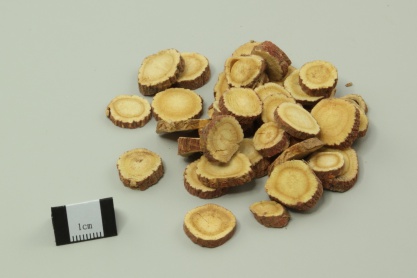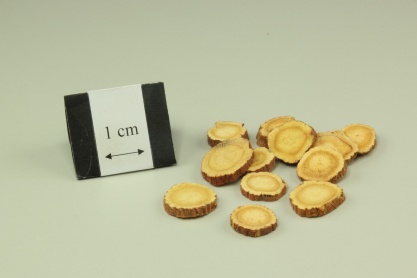- ENG
- Liquorice Root
- LATIN
- Glycyrrhizae Radix et Rhizoma
| Medicinal Group | Qi-tonifying medicinal |
|---|---|
| Source | Dried root and rhizome of Glycyrrhiza uralensis Fish., Glycyrrhiza inflata Bat. or Glycyrrhiza glabra L. (Fam. Leguminosae) |
| Nature and Flavors | sweet; neutral |
| Meridian Affinity | Heart, Spleen, Lung, Stomach |
| Actions | To reinforce the function of the spleen and replenish qi, remove heat and counteract toxcity, dispel phlegm and relieve cough, alleviate spasmodic pain, and moderate drug actions |
Family
Part used
Indications
Hypofunction of the spleen and the stomach marked by lassitude and weakness; cardiac palpitation and shortness of breath; cough with much phlegm; spasmodic pain in the epigastrium, abdomen and limbs; carbuncles and sores, also used for reducing the toxic or drastic actions of other drugs
Research Findings
- Glycyrrhizin is the major active constituent obtained from liquorice roots, one of the most widely used in herbal preparations for the treatment of liver complaints.[1]
- In vivo and clinical studies have reported beneficial effects of both licorice and glycyrrhizin consumption including anti-ulcer, anti-viral, and hepatoprotective responses.[2]
- Both aqueous and ethanolic liquorice extracts are potent cariostatic agents and are found to be palatable by child patients.[3]
- A potential for simple effective caries-prevention for high-risk children has been demonstrated by a clinical intervention using sugar-free lollipops containing liquorice root extract. [4]
Cautions
Incompatible with Radix Euphorbiae Pekinensis, Flos Genkwa and Radix Kansui
Report on adverse effect
Prolonged use (6 weeks) of excessive doses (50g/day) can lead to pseudoaldosteronism, which includes potassium depletion, sodium retention, oedema, hypertension, and weight gain [5, 6, 7]
Myoglobinuria and myopathy can occur [8]
Hepatotoxicity in patients with chronic hepatitis B infection [9]
Adverse reactions on the cardiovascular system may occur when using together with western medicine [10]
Reference
Reference
- Dastagir G, Rizvi MA. (2016). Review - Glycyrrhiza glabra L. (Liquorice). Pak J Pharm Sci. , 29(5):1727-1733.
- Isbrucker RA, Burdock GA. ( 2006). Risk and safety assessment on the consumption of Licorice root (Glycyrrhiza sp.), its extract and powder as a food ingredient, with emphasis on the pharmacology and toxicology of glycyrrhizin. Regul Toxicol Pharmacol. , 46(3):167-92. Epub 2006 Aug 1.
- Jain E, Pandey RK, Khanna R. ( 2013). Liquorice root extracts as potent cariostatic agents in pediatric practice. J Indian Soc Pedod Prev Dent. , 31(3):146-52. doi: 10.4103/0970-4388.117964.
- Peters MC, Tallman JA, Braun TM, Jacobson JJ. ( 2010). Clinical reduction of S. mutans in pre-school children using a novel liquorice root extract lollipop: a pilot study. Eur Arch Paediatr Dent. , 11(6):274-8.
- Bradley PR, ed. British herbal compendium, Vol. 1. Bournemouth, British Herbal Medicine Association, 1992:145–148.
- Epistein MT et al. Effects of eating liquorice on the renin-angiotensin aldosterone axis in normal subjects. British medical journal, 1977, 1:488–490.
- Stewart PM et al. Mineralocorticoid activity of liquorice: 11- hydroxysteroid dehydrogenase deficiency comes of age. Lancet, 1987, ii:821–824.
- Caradonna P et al. Acute myopathy associated with chronic licorice ingestion: Reversible loss of myoadenylate deaminase activity. Ultrastructural pathology, 1992, 16:529–535.
- 何吉芬 (2010)。<淺談甘草及其製劑的毒副作用>。中國中醫藥現代遠程教育,23。
- Yuen MF, Tam S, Fung J, Wong D, Wong B, Lai CL (2006) Traditional Chinese medicine causing hepatotoxicity in patients with chronic hepatitis B infection: a 1-year prospective study. Aliment.Pharmacol.Ther., 24, 8, 1179-1186.














